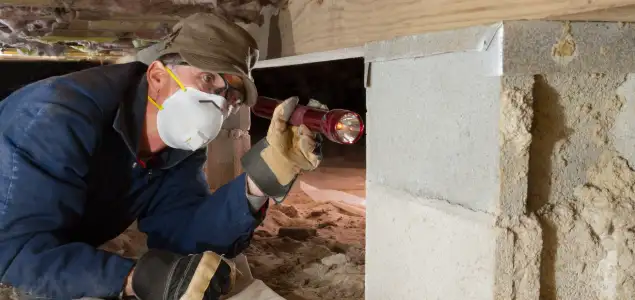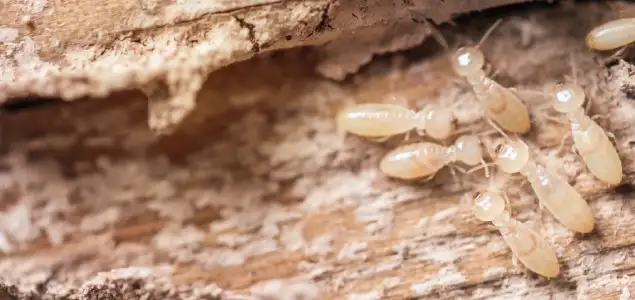Contact Us Today for Quote!
GET QUICK QUOTE
Termites Gold Coast and Tweed
All you need to know about termites and how to protect your home…
- As many as 1 in 3 homes on the Gold Coast will be attacked by termites
- Termite damage is not covered by standard home insurance policies
- A termite management plan is a must to protect your property from termite attack
Richards Pest Control have been trusted to protect Gold Coast homes from termites for nearly 70 years!
The reason for this longevity is that we ensure our termite team keep up to speed with the latest research on termite behaviour and we use the latest detection technology and termite control products to keep your home safe from termite attack.
Richards Pest Control are fully licensed and insured to provide termite inspections and termite treatments giving homeowners confidence that their home is in good hands.
Three actions to protect your home from termites
Regular Termite Inspections
Whatever the construction type of your home, annual termite inspections are a must for all homeowners. Australian Standards, Building Authorities and Governments all recommend professional termite inspections, as least once a year and more often in areas of high termite pressure.
Annual termite inspections are still required for new homes and for homes with termite management systems in place in order to maintain any warranties. Metal framed homes can still come under termite attack – if there is wood in the house and termite can find a way in…
A profession termite inspection is not the same as a free ‘termite check’. A termite inspection will take at least 1.5-2 hours and will result in a comprehensive, formal inspection report. There is no insurance protection if termite activity is missed during a ‘termite check’. Learn more about termite inspections…
A termite inspection will identify areas of termite activity, termite damage and conditions around the property that could make a termite attack more likely. Dealing with these conducive conditions will significantly reduce the risk of a termite attack. However, to protect the building from termite attack, a termite management system is required.
Install a termite management system
A termite management system works in conjunction with the physical features of the building to prevent concealed termite attack.
There are two types of termite management system:
- A termite chemical soil treatment around and under your home
- A termite monitoring and baiting system
Even with a termite management system in place, it is still important to have annual termite inspections to check if termites are trying to find a way around the termite protection measures and that the termite management system hasn’t been compromised.
Learn more about termite treatments and termite management systems…
Make your home less attractive to termites
The termite inspection report will list any building faults or conditions around the building that may make a termite attack more likely. Most of these conducive conditions fall into two key areas – reducing moisture and eliminating hidden entry points.
Reducing moisture
- Ensure there is good drainage around and under the home – if the soil is dry around the home, it is very unattractive to termites!
- Fix leaking taps and pipework (inside and outside the home)
- Ensure there are no leaking gutters and that downpipes enter a drain
- Hot water overflows and air conditioning condensate need to feed into drains
- Avoid having a watering system or water plants directly adjacent to the building
Eliminating hidden termite entry points
- Keep vegetation away from the edge of the building – makes the area less attractive and allows the edge of the building to be easily viewed
- Don’t build up garden beds next to the edge of the building
- Don’t lay paths or driveways above the height of the termite protection built into the construction
- Don’t store goods in the sub-floor that obscures or touches sub-floor timbers
Termite information
Termites or white ants?
Some people call termites, “white ants”, but termites aren’t ants at all. In fact, there are actually more closely related to cockroaches.
Photo of termite worker & ant worker
Once you know the differences, it’s pretty easy to tell the difference between a termite and an ant:
- Worker termites are a white or pale mottled colour. Ants are black or brown in colour
- Termites appear to have two body segments (but there’s actually three), ants have three obvious body segments with a distance waist
- Termite antennae are straight. Ant antennae are bent.
- Termite workers are blind. You should be able to see obvious eyes on ants.
If you think you have termites, give Richards Pest Control a call immediately
Types of termites on the Gold Coast
icant damage in 6-12 months. Schedorhinotermes can be more difficult to control as they often build lot of small nests as part of the same colony – if you kill only one nest, there will still be others in the area to attack your home.
There are also two rarer types of termites that do occasionally appear on the Gold Coast, the giant northern termite (Mastotermes darwiniensis) and drywood termites. The giant northern termite is a very serious subterranean termite more often found in the tropical north and can destroy a house in months. Drywood termites are a different type of termite and they don’t need the same level of moisture or soil contact as subterranean termites. They can be very difficult to locate and control as they build lots of small nests throughout a building and are very expensive to control as the whole house needs to be fumigated.
Termite nests
Many subterranean termite nests are hidden underground or in the trunks of trees. It is often quoted that 80% of all Australian homes are within 25m of a termite nest. With termites able to travel 100m or more from their nest to a feeding site, most homes in Australia are under threat of termite attack.
When we start a termite treatment, we always try and find any nests on the property. There is often no way of knowing if any nest that is found is the one attacking the home, but it obviously makes sense to treat any nests that are found. If nests cannot be located to allow for direct nest treatment, we will often use termite baits to kill the colony that’s attacking the home.
Coptotermes and Nasutitermes also produce large single nests. Although Coptotermes nests are generally well hidden, Nasutitermes nests are generally easy to spot as they products obvious mounds. Schedorhinotermes nests are also well hidden, but they are also a “multi-nester” which can make them more difficult to control. They can develop a number of nests (all part of the same colony), in a small area, which means you can often have several nests attacking the same building.
Flying termites
Flying termites (alates) are reproductive termites , the new queens and kings that get released from mature nests in great numbers on warm, humid nights. These mating flights start in spring but may continue through the summer on the Gold Coast. They will be attracted to lights in the evening.
During the flight, the flying termites pair off, land and their wings fall off. They then walk off together to try and find a location to start a new nest. Sometimes you may see piles of wings on the floor or under windows when you get up in the morning.
Flying termites are different to the workers and look more like ants. Not only do they have wings, but they are a brown colour with obvious eyes.
Flying termites do not fly far from their nest, so if you find flying termites outside or inside your home, you must get an inspection immediately. The nest may not be in your home, but it won’t be far away and so your home will be under threat.
If you spot flying termites in or near your home, please contact Richards Pest Control immediately.
Termite queen
The termite queen is the most important termite in the colony as she produces all the eggs. In fact, she can produce several thousand eggs a day! Some species will have more than one queen in the nest, so you can see how termite nest can quickly grow to become a significant threat to your home.
To eliminate a termite nest, it is necessary to kill the queen(s). This is why spraying termites with a household insecticide spray is a waste of time. It may kill a few, but there will be thousands more back in the nest and the queen will quickly replace the few termites that have been killed.
Termite workers
The termite workers (the “white ants”) are the termites that do all the damage. They chew up bits of wood, which is digested with the help of microbes in their stomachs. It is then fed to the queen, developing nymphs and other termites back in the nest.
Termite soldiers
The termite soldiers, as their name suggests, provide protection for the colony. Although they generally have white bodies, they have darker and larger heads than worker termites and have larger or modified jaws, which allows them to attack invaders. The soldiers generally make up 5-10% of the colony and can be very useful in helping termite professionals identify the species.


